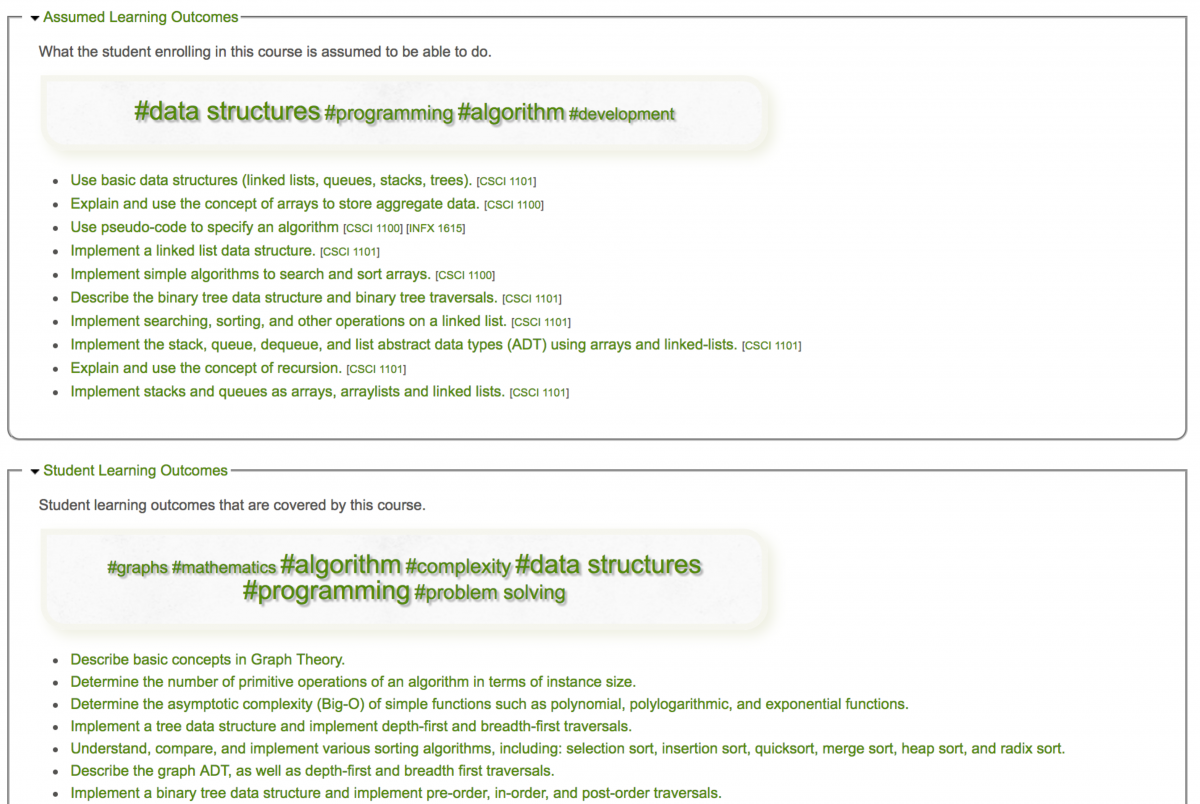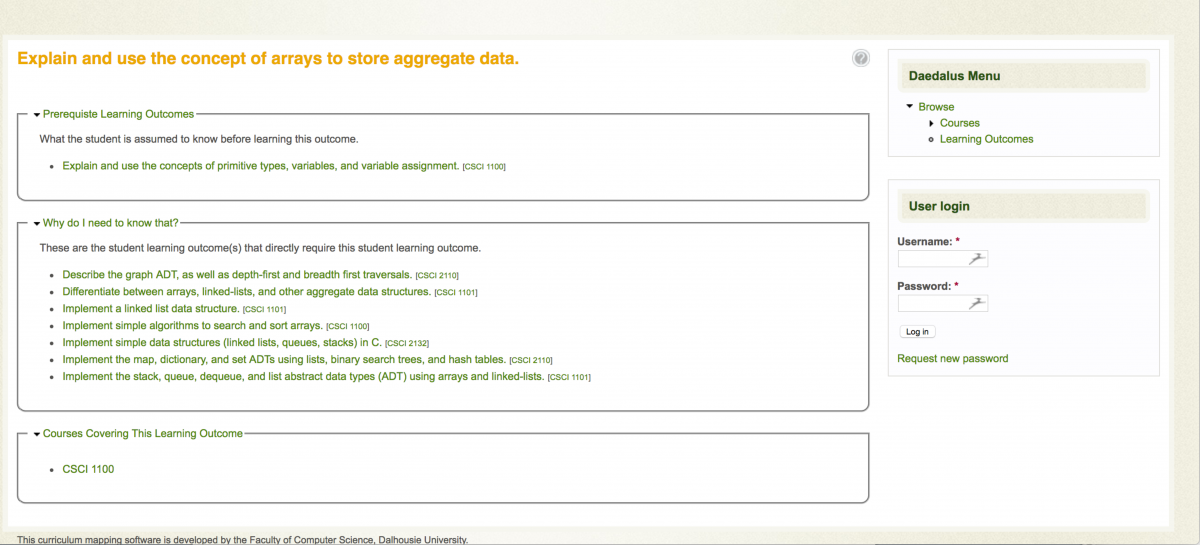Opportunity
In 2002, the Department of Computer Science at Dalhousie University in Halifax, Nova Scotia, was facing a major problem - too many students failing the Bachelor of Computer Science program.
A lack of cohesion and sequencing between the different courses in the program were identified from feedback from students and from discussion between faculty within the department. Students often did not know why they should choose specific courses in the program, nor in which order they should register in them. Students entered the program wanting, for example, to be a star video game designer, but had no idea what courses would be appropriate. In particular, the core theory students needed for other content areas was not available early enough in the program.
The faculty, therefore, decided there was a need for a core curriculum that all students should cover in order to complete successfully the program. However, among faculty, there was no agreement or shared understanding of what that 'core' computer science curriculum was.
To help resolve this challenge, the Faculty of Computer Science decided to develop a tool to assist program design and review and to help students and instructors better understand all the academic components of the degree program. To do this, a learning outcomes approach was chosen as the basis for a curriculum map to facilitate the discussion of curricular issues.
The exercise was led by the current Associate Dean of the Faculty of Science, Professor Christian Blouin, in a partnership between the Provost's office and the Centre for Learning and Teaching. The result is the creation of an online curriculum planning tool called Daedalus. Daedalus was a Greek god, who among other things, created the Labyrinth that contained the Minotaur.
Innovation
The aim was to develop a map showing the inter-relatedness between specific learning outcomes, course content, and course and learning outcome sequencing.
To do this, each faculty member was asked to identify the learning outcomes for their course by answering the following question:
“What is the smallest amount of information a student will need to answer the key questions in this course?”
Once these learning outcomes were identified, they were tagged (coded) so they could be linked to other relevant learning outcomes in the program. Using the tags, a learning outcome could be linked backward to a pre-requisite learning outcome or forward to an outcome for which it would be a pre-requisite.
Then agreement was sought among faculty about:
- The importance of each learning outcome within the program; and
- Where in the program each learning outcome would be best addressed, in relation to any pre-requisites and its link to learning outcomes that followed.
By 2012, the first online 'working map' was developed. Figure 1 is the course map for CSCI 2110, showing there are two pre-requisite courses, CSCI 1101 and CSCI 1100, and CS 2110 is a pre-requisite for nine courses at the next level and six courses at the level beyond.

Linked to this course map for CSCI 2110 are two sets of learning outcomes (see Figure 2 below): one for assumed learning outcomes the student should already have covered before taking this course, and then a list of the learning outcomes covered by the course itself.

Each of the listed outcomes is 'hot linked' so a student or instructor can click on the outcome. This leads to a screen (see Figure 3) that provides the following information on the learning outcome:
- Pre-requisite learning outcomes (also hot-linked for more information);
- Why do I need to learn that? (indicating other learning outcomes dependent on this learning outcome; and
- Which course or courses cover this learning outcome.

An appropriate mechanism for curriculum discussion at the program level is critical for the success of the tool, to enable the learning outcomes and their appropriate sequence to be discussed and agreed. The Faculty of Computer Science at Dalhousie established a curriculum committee for this purpose.
In particular, a bottom-up approach is needed where learning outcomes are identified by individual instructors who then come together for discussion and agreement at a program level.
The software to develop the curriculum map is relatively simple, using a relational database. It is left to each instructor to decide how learning outcomes should be categorized, although the Daedalus team provides technical support such as data entry.
Benefits and Outcomes
The main benefit of the mapping tool is it provides a framework or stimulus for an objective, rationale discussion about curriculum content, learning outcomes, and course and content sequencing. Its most common use is when someone (instructor or student) challenges the need for a pre-requisite learning outcome in a specific course.
The tool also led to the development of an efficient, logically sequenced bachelor's program that provides a strong foundation in computer science, by providing a 'whole world' view of the curriculum and avoiding overloading of courses and unnecessary duplication. In particular, core theory was moved into first year courses to support later learning outcomes.
Almost as important though is the information the tool provides to students in the program about what they are learning, why, and in what sequence. Indeed, students now complain if a particular instructor strays outside the curriculum map.
It is also a major help to new instructors who can see where their own courses fit within the overall structure, and provides a framework for determining and defining the learning outcomes for their own courses.
There are now over 40 programs across a wide range of academic departments at Dalhousie University using a curriculum map, with a further 11 other universities using Daedalus.
Challenges and Enhancements
The main challenge was getting instructors to be able to define (and agree upon) learning outcomes. Daedalus includes training materials on defining learning outcomes and the Centre for Teaching and Learning also offers workshops and short presentations on the topic.
Initially there was one category of tags (courses), but other tags or sub-tags can be, and are being added, such as searching outcomes by topics.
The next step is to develop a self-advising tool for students on course choices.
Although computer science is a rapidly changing area of knowledge, at the undergraduate level the 'core' of the subject is not rapidly changing, at least not until the final year. It is nevertheless an ongoing exercise to analyze new developments in computer science to identify the potential implications for earlier stages of the curriculum map.
There is also a danger of focusing too much on the tool and not enough on the policies that structure the tool. The tool is basically a container but it can influence the way instructors conform to its shape. Thus ensuring there are appropriate mechanisms for curriculum discussion and a 'bottom-up' approach to defining learning outcomes is essential for success.
Potential
This tool is invaluable for any program with an emphasis on developing and measuring specific learning outcomes, and for competency-based learning.
Even (or especially) in areas where learning outcomes are more difficult to define or measure, the tool could be useful for tracking more general learning outcomes, such as the development of critical thinking or problem-solving skills, so their development can be tracked across different courses in the same program. In particular, the tool is invaluable for generating a structured discussion on such curricula.
Professor Blouin and his team are willing to work with other departments and colleges or universities who would like to test or use the tool.
Further Information
Professor Christian Blouin
Faculty of Computer Science
Dalhousie University,
Halifax, Nova Scotia
[email protected]


